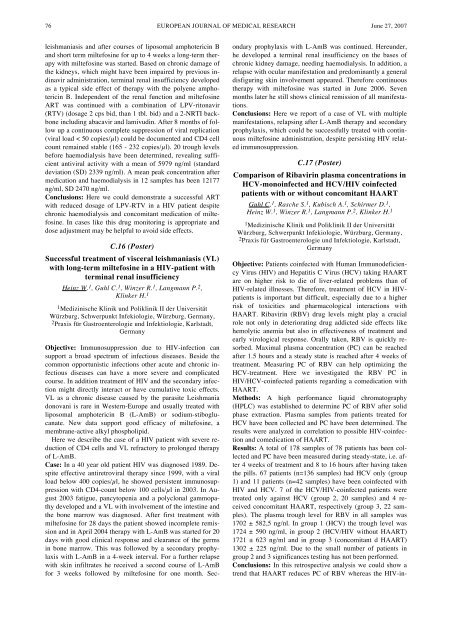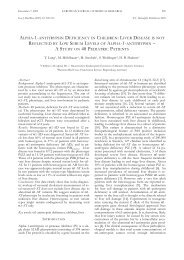European Journal of Medical Research - Deutsche AIDS ...
European Journal of Medical Research - Deutsche AIDS ...
European Journal of Medical Research - Deutsche AIDS ...
You also want an ePaper? Increase the reach of your titles
YUMPU automatically turns print PDFs into web optimized ePapers that Google loves.
76 EUROPEAN JOURNAL OF MEDICAL RESEARCH<br />
June 27, 2007<br />
leishmaniasis and after courses <strong>of</strong> liposomal amphotericin B<br />
and short term miltefosine for up to 4 weeks a long-term therapy<br />
with miltefosine was started. Based on chronic damage <strong>of</strong><br />
the kidneys, which might have been impaired by previous indinavir<br />
administration, terminal renal insufficiency developed<br />
as a typical side effect <strong>of</strong> therapy with the polyene amphotericin<br />
B. Independent <strong>of</strong> the renal function and miltefosine<br />
ART was continued with a combination <strong>of</strong> LPV-ritonavir<br />
(RTV) (dosage 2 cps bid, than 1 tbl. bid) and a 2-NRTI backbone<br />
including abacavir and lamivudin. After 8 months <strong>of</strong> follow<br />
up a continuous complete suppression <strong>of</strong> viral replication<br />
(viral load < 50 copies/l) could be documented and CD4 cell<br />
count remained stable (165 - 232 copies/l). 20 trough levels<br />
before haemodialysis have been determined, revealing sufficient<br />
antiviral activity with a mean <strong>of</strong> 5979 ng/ml (standard<br />
deviation (SD) 2339 ng/ml). A mean peak concentration after<br />
medication and haemodialysis in 12 samples has been 12177<br />
ng/ml, SD 2470 ng/ml.<br />
Conclusions: Here we could demonstrate a successful ART<br />
with reduced dosage <strong>of</strong> LPV-RTV in a HIV patient despite<br />
chronic haemodialysis and concomitant medication <strong>of</strong> miltefosine.<br />
In cases like this drug monitoring is appropriate and<br />
dose adjustment may be helpful to avoid side effects.<br />
C.16 (Poster)<br />
Successful treatment <strong>of</strong> visceral leishmaniasis (VL)<br />
with long-term miltefosine in a HIV-patient with<br />
terminal renal insufficiency<br />
Heinz W. 1 , Guhl C. 1 , Winzer R. 1 , Langmann P. 2 ,<br />
Klinker H. 1<br />
1 Medizinische Klinik und Poliklinik II der Universität<br />
Würzburg, Schwerpunkt Infekiologie, Würzburg, Germany,<br />
2 Praxis für Gastroenterologie und Infektiologie, Karlstadt,<br />
Germany<br />
Objective: Immunosuppression due to HIV-infection can<br />
support a broad spectrum <strong>of</strong> infectious diseases. Beside the<br />
common opportunistic infections other acute and chronic infectious<br />
diseases can have a more severe and complicated<br />
course. In addition treatment <strong>of</strong> HIV and the secondary infection<br />
might directly interact or have cumulative toxic effects.<br />
VL as a chronic disease caused by the parasite Leishmania<br />
donovani is rare in Western-Europe and usually treated with<br />
liposomal amphotericin B (L-AmB) or sodium-stiboglucanate.<br />
New data support good efficacy <strong>of</strong> miltefosine, a<br />
membrane-active alkyl phospholipid.<br />
Here we describe the case <strong>of</strong> a HIV patient with severe reduction<br />
<strong>of</strong> CD4 cells and VL refractory to prolonged therapy<br />
<strong>of</strong> L-AmB.<br />
Case: In a 40 year old patient HIV was diagnosed 1989. Despite<br />
effective antiretroviral therapy since 1999, with a viral<br />
load below 400 copies/l, he showed persistent immunosuppression<br />
with CD4-count below 100 cells/l in 2003. In August<br />
2003 fatigue, pancytopenia and a polyclonal gammopathy<br />
developed and a VL with involvement <strong>of</strong> the intestine and<br />
the bone marrow was diagnosed. After first treatment with<br />
miltefosine for 28 days the patient showed incomplete remission<br />
and in April 2004 therapy with L-AmB was started for 20<br />
days with good clinical response and clearance <strong>of</strong> the germs<br />
in bone marrow. This was followed by a secondary prophylaxis<br />
with L-AmB in a 4-week interval. For a further relapse<br />
with skin infiltrates he received a second course <strong>of</strong> L-AmB<br />
for 3 weeks followed by miltefosine for one month. Secondary<br />
prophylaxis with L-AmB was continued. Hereunder,<br />
he developed a terminal renal insufficiency on the bases <strong>of</strong><br />
chronic kidney damage, needing haemodialysis. In addition, a<br />
relapse with ocular manifestation and predominantly a general<br />
disfiguring skin involvement appeared. Therefore continuous<br />
therapy with miltefosine was started in June 2006. Seven<br />
months later he still shows clinical remission <strong>of</strong> all manifestations.<br />
Conclusions: Here we report <strong>of</strong> a case <strong>of</strong> VL with multiple<br />
manifestations, relapsing after L-AmB therapy and secondary<br />
prophylaxis, which could be successfully treated with continuous<br />
miltefosine administration, despite persisting HIV related<br />
immunosuppression.<br />
C.17 (Poster)<br />
Comparison <strong>of</strong> Ribavirin plasma concentrations in<br />
HCV-monoinfected and HCV/HIV coinfected<br />
patients with or without concomitant HAART<br />
Guhl C. 1 , Rasche S. 1 , Kubisch A. 1 , Schirmer D. 1 ,<br />
Heinz W. 1 , Winzer R. 1 , Langmann P. 2 , Klinker H. 1<br />
1 Medizinische Klinik und Poliklinik II der Universität<br />
Würzburg, Schwerpunkt Infekiologie, Würzburg, Germany,<br />
2 Praxis für Gastroenterologie und Infektiologie, Karlstadt,<br />
Germany<br />
Objective: Patients coinfected with Human Immunodeficiency<br />
Virus (HIV) and Hepatitis C Virus (HCV) taking HAART<br />
are on higher risk to die <strong>of</strong> liver-related problems than <strong>of</strong><br />
HIV-related illnesses. Therefore, treatment <strong>of</strong> HCV in HIVpatients<br />
is important but difficult, especially due to a higher<br />
risk <strong>of</strong> toxicities and pharmacological interactions with<br />
HAART. Ribavirin (RBV) drug levels might play a crucial<br />
role not only in deteriorating drug addicted side effects like<br />
hemolytic anemia but also in effectiveness <strong>of</strong> treatment and<br />
early virological response. Orally taken, RBV is quickly resorbed.<br />
Maximal plasma concentration (PC) can be reached<br />
after 1.5 hours and a steady state is reached after 4 weeks <strong>of</strong><br />
treatment. Measuring PC <strong>of</strong> RBV can help optimizing the<br />
HCV-treatment. Here we investigated the RBV PC in<br />
HIV/HCV-coinfected patients regarding a comedication with<br />
HAART.<br />
Methods: A high performance liquid chromatography<br />
(HPLC) was established to determine PC <strong>of</strong> RBV after solid<br />
phase extraction. Plasma samples from patients treated for<br />
HCV have been collected and PC have been determined. The<br />
results were analyzed in correlation to possible HIV-coinfection<br />
and comedication <strong>of</strong> HAART.<br />
Results: A total <strong>of</strong> 178 samples <strong>of</strong> 78 patients has been collected<br />
and PC have been measured during steady-state, i.e. after<br />
4 weeks <strong>of</strong> treatment and 8 to 16 hours after having taken<br />
the pills. 67 patients (n=136 samples) had HCV only (group<br />
1) and 11 patients (n=42 samples) have been coinfected with<br />
HIV and HCV. 7 <strong>of</strong> the HCV/HIV-coinfected patients were<br />
treated only against HCV (group 2, 20 samples) and 4 received<br />
concomitant HAART, respectively (group 3, 22 samples).<br />
The plasma trough level for RBV in all samples was<br />
1702 ± 582,5 ng/nl. In group 1 (HCV) the trough level was<br />
1724 ± 590 ng/ml, in group 2 (HCV/HIV without HAART)<br />
1721 ± 623 ng/ml and in group 3 (concomitant d HAART)<br />
1302 ± 225 ng/ml. Due to the small number <strong>of</strong> patients in<br />
group 2 and 3 significances testing has not been performed.<br />
Conclusions: In this retrospective analysis we could show a<br />
trend that HAART reduces PC <strong>of</strong> RBV whereas the HIV-in-





